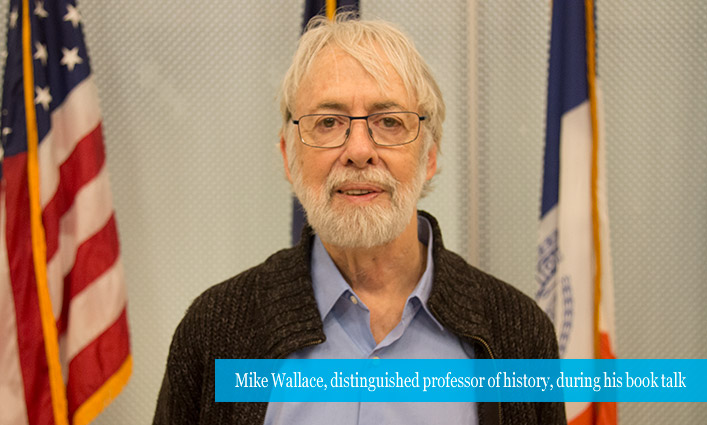
Mike Wallace, Distinguished Professor of History at John Jay and the Director of the Gotham Center for New York City History presented his book Greater Gotham: A History of New York City from 1898 to 1919 at the first book talk in the Spring 2019 Book Talk Series hosted by the Office for the Advancement of Research. In honor of New Yorkers’ intrinsic obsession with speed, Wallace began by telling the audience, “I’m going to whisk you through my 1,200-page tome in under half an hour and provide you with a nuance free overview of some of its major propositions. So grab a strap and hang on. The express is leaving the station.”
The sequel to the Pulitzer Prize winning Gotham, co-written by Edwin G. Burrows, Greater Gotham examines two of the most formative decades in the City’s history—encapsulating a time of great economic prosperity, consolidation, and a surge in immigration. “The economy came roaring back to life,” said Wallace. “It was during this time that reconstruction of American capitalism, engineered by industrial titans such as JP Morgan and John D. Rockefeller, took place. Skyscrapers erupted from the bedrock of lower Manhattan. Bridges were built across rivers, subways were dug beneath the landscape, and the population quickly expanded.”

“The number of absences from the historical narrative produced are enormous. Blacks weren’t included in the mix, women weren’t part of the national narrative—that is half the population—and the working class was left out.” – Mike Wallace
Telling the Untold Stories
This growth became the template of what New York would eventually become—the ultimate melting pot of cultures—but it also led to conflict, as Wallace explained. “A considerable portion of the book is devoted to the era’s tumultuous conflict over New York’s social, cultural, economic, and political arrangements. We have time for only a glance of four of the era’s battlegrounds whose combatants were divided among class, ethnicity, race, and gender.”
Viewing history through the lens of the poor, immigrants, blacks, and women, enabled Wallace to paint a deeper, more complex picture of New York City’s history, helping to bridge the gap left behind by earlier historical narratives. “The number of absences from the historical narrative produced are enormous,” said Wallace. “Blacks weren’t included in the mix, women weren’t part of the national narrative—that is half the population—and the working class was left out.” By telling these untold stories, Wallace provides the reader with details on the rise of the super-rich and the chasm that grew between the Bowery and Fifth Avenue. He explores the creation of Black Harlem and the way organizations, like the National Association for the Advancement of Colored People (NAACP), which was established in 1909, created pathways of resistance to racism. He analyzes the entrance of women in the industrial, commercial, and cultural job sectors; and examines the struggle of immigrants.

The Writing Process
During a Q&A session that followed the reading, Wallace was asked about the enormity of the project and how he decided on what stories should stay and go. “I have a hierarchy of attention. First and foremost is the city’s changing position on the planet. And then its attention to infrastructure and developments. It’s almost like a checklist,” he said. “Then I write about the people, I tell their stories. To some extent when you write the story, what you don’t need becomes clearer.” When one audience member asked Wallace, “Why New York City? What makes it distinctive from any other American city, like Philadelphia?” Wallace quickly ran down a list of reasons: “One, Wall Street. Two, the political power on the national level because of Wall Street. And three, the ports. The ports equal the arrival of capital, immigration, and cultural exchanges, theater, opera, and so forth.” One of the final questions of the evening was about the publishing date for the next volume in the Gotham series. Wallace provided some details, telling the audience he’s already writing it. “It will cover the history of the City from the end of World War I to the end of World War II,” said Wallace. But he offered no details on a publishing date, instead he quipped, “I’ll be as happy as anybody to see it coming hot off the press.”



